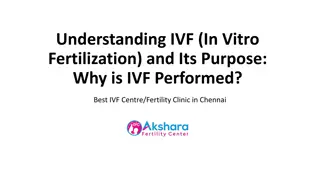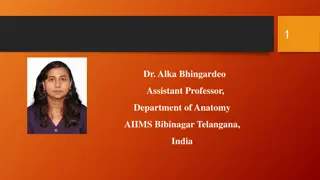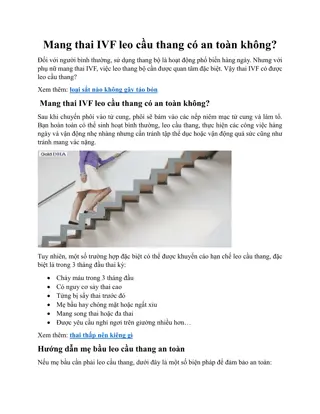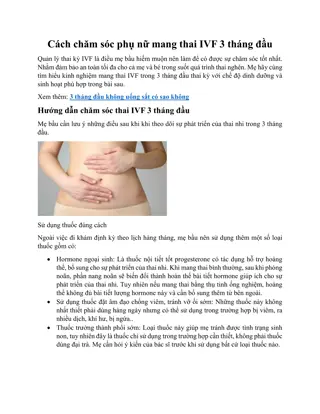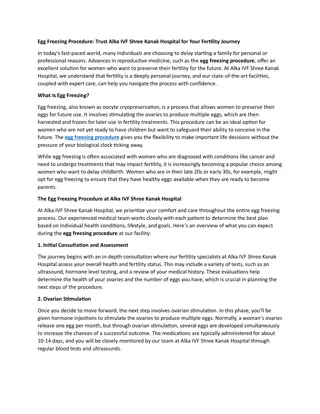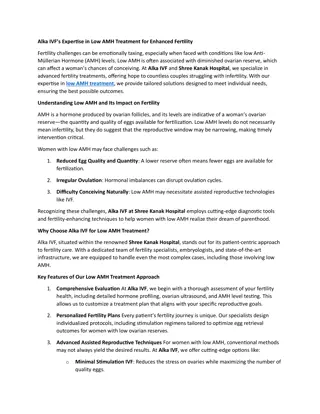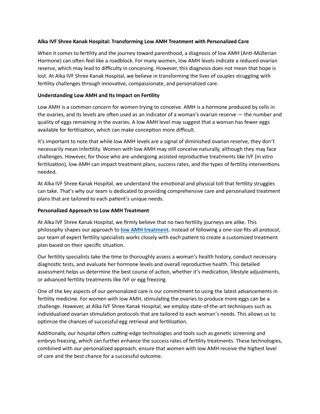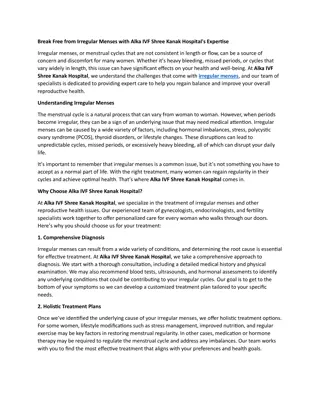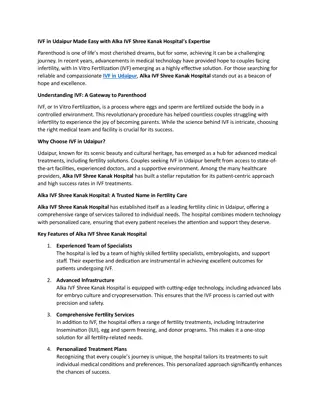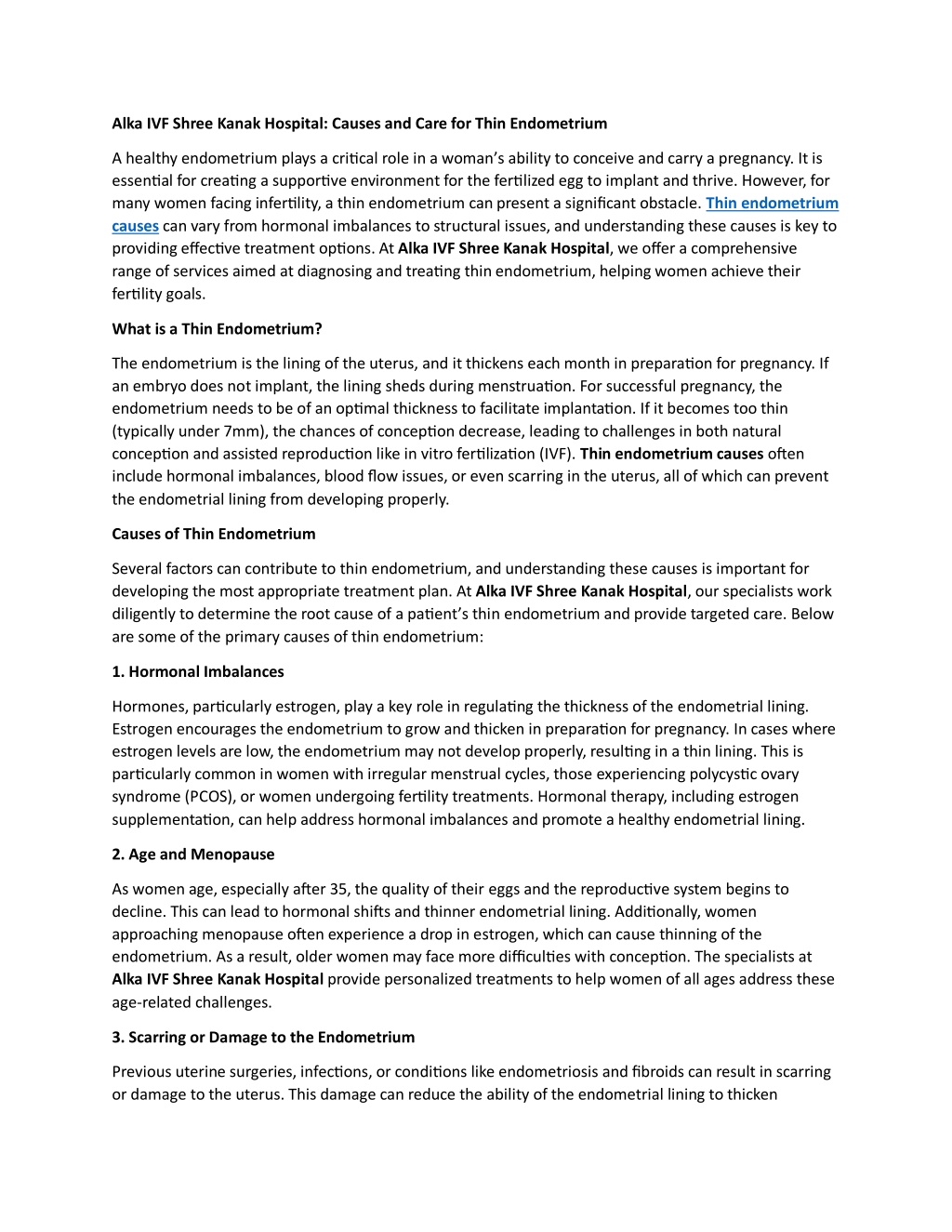
Alka IVF Shree Kanak 20 nov.
thin endometrium causes
Download Presentation

Please find below an Image/Link to download the presentation.
The content on the website is provided AS IS for your information and personal use only. It may not be sold, licensed, or shared on other websites without obtaining consent from the author. Download presentation by click this link. If you encounter any issues during the download, it is possible that the publisher has removed the file from their server.
E N D
Presentation Transcript
Alka IVF Shree Kanak Hospital: Causes and Care for Thin Endometrium A healthy endometrium plays a critical role in a woman s ability to conceive and carry a pregnancy. It is essential for creating a supportive environment for the fertilized egg to implant and thrive. However, for many women facing infertility, a thin endometrium can present a significant obstacle. Thin endometrium causes can vary from hormonal imbalances to structural issues, and understanding these causes is key to providing effective treatment options. At Alka IVF Shree Kanak Hospital, we offer a comprehensive range of services aimed at diagnosing and treating thin endometrium, helping women achieve their fertility goals. What is a Thin Endometrium? The endometrium is the lining of the uterus, and it thickens each month in preparation for pregnancy. If an embryo does not implant, the lining sheds during menstruation. For successful pregnancy, the endometrium needs to be of an optimal thickness to facilitate implantation. If it becomes too thin (typically under 7mm), the chances of conception decrease, leading to challenges in both natural conception and assisted reproduction like in vitro fertilization (IVF). Thin endometrium causes often include hormonal imbalances, blood flow issues, or even scarring in the uterus, all of which can prevent the endometrial lining from developing properly. Causes of Thin Endometrium Several factors can contribute to thin endometrium, and understanding these causes is important for developing the most appropriate treatment plan. At Alka IVF Shree Kanak Hospital, our specialists work diligently to determine the root cause of a patient s thin endometrium and provide targeted care. Below are some of the primary causes of thin endometrium: 1. Hormonal Imbalances Hormones, particularly estrogen, play a key role in regulating the thickness of the endometrial lining. Estrogen encourages the endometrium to grow and thicken in preparation for pregnancy. In cases where estrogen levels are low, the endometrium may not develop properly, resulting in a thin lining. This is particularly common in women with irregular menstrual cycles, those experiencing polycystic ovary syndrome (PCOS), or women undergoing fertility treatments. Hormonal therapy, including estrogen supplementation, can help address hormonal imbalances and promote a healthy endometrial lining. 2. Age and Menopause As women age, especially after 35, the quality of their eggs and the reproductive system begins to decline. This can lead to hormonal shifts and thinner endometrial lining. Additionally, women approaching menopause often experience a drop in estrogen, which can cause thinning of the endometrium. As a result, older women may face more difficulties with conception. The specialists at Alka IVF Shree Kanak Hospital provide personalized treatments to help women of all ages address these age-related challenges. 3. Scarring or Damage to the Endometrium Previous uterine surgeries, infections, or conditions like endometriosis and fibroids can result in scarring or damage to the uterus. This damage can reduce the ability of the endometrial lining to thicken
properly, leading to a thin endometrium. In these cases, treatment may include surgery to remove the scar tissue or medications that support endometrial regeneration and healing. Alka IVF Shree Kanak Hospital offers advanced diagnostic tools and treatments for these types of issues. 4. Poor Blood Flow to the Uterus The health of the endometrial lining depends largely on the blood flow to the uterus. Reduced blood circulation can hinder the nourishment needed for proper endometrial growth. Conditions such as high blood pressure, diabetes, or pelvic inflammatory disease (PID) can impair blood flow to the uterus, resulting in a thin endometrium. Addressing the underlying health issues and improving blood flow are essential in these cases. 5. Lifestyle Factors Certain lifestyle choices can also play a role in the development of thin endometrium. Smoking, excessive stress, poor diet, and obesity can all interfere with hormonal balance and reproductive health. Leading a healthy lifestyle with proper nutrition, regular exercise, and stress management can help improve the overall health of the reproductive system and support endometrial development. 6. Medications Some fertility medications, particularly Clomid (Clomiphene Citrate), are known to affect endometrial thickness. While Clomid is used to stimulate ovulation, it can sometimes lead to a thinner endometrial lining, especially if used over a prolonged period. In such cases, adjustments to the medication protocol or switching to other fertility treatments may be necessary. At Alka IVF Shree Kanak Hospital, fertility experts work closely with patients to monitor their response to medications and make the necessary adjustments to improve outcomes. How Alka IVF Shree Kanak Hospital Treats Thin Endometrium At Alka IVF Shree Kanak Hospital, we understand how a thin endometrium can impact a woman s fertility. Our experienced team of doctors and fertility specialists are committed to offering personalized care that targets the root causes of thin endometrium. Depending on the underlying cause, we employ a variety of treatments to enhance endometrial thickness and improve the chances of successful conception. 1. Hormonal Therapy For women with hormonal imbalances, estrogen supplementation is commonly used to promote endometrial growth. Hormonal treatments can help restore the ideal environment in the uterus, making it more receptive to embryo implantation. In some cases, progesterone may also be prescribed to help maintain the endometrial lining after ovulation. 2. Platelet-Rich Plasma (PRP) Therapy Platelet-Rich Plasma (PRP) therapy is an innovative treatment that has shown promising results in improving endometrial thickness. This procedure involves extracting platelets from the patient s own blood, concentrating them, and then injecting the PRP into the endometrium to stimulate tissue regeneration and improve blood flow. PRP therapy is a safe and effective option offered at Alka IVF Shree Kanak Hospital for women with thin endometrium.
3. In Vitro Fertilization (IVF) For women with severely thin endometrial linings, IVF may be the best option. IVF allows for precise control over the development of the endometrial lining and embryo transfer. During an IVF cycle, specialists at Alka IVF Shree Kanak Hospital closely monitor the endometrial thickness to ensure that it is optimal for implantation. If necessary, the clinic will use additional treatments like hormone therapy or PRP to improve the lining before embryo transfer. 4. Surgical Interventions In cases where scarring, fibroids, or adhesions are causing thin endometrium, surgical interventions such as hysteroscopy may be recommended. This minimally invasive procedure can remove blockages or scar tissue, restoring normal uterine function and improving the chances of endometrial regeneration. Conclusion A thin endometrium can significantly impact a woman s fertility, but with the right care and treatment, it is possible to overcome this challenge. At Alka IVF Shree Kanak Hospital, we focus on identifying the underlying thin endometrium causes and providing personalized treatment plans to improve endometrial health. Whether through hormonal therapy, PRP treatment, IVF, or surgery, our specialists are dedicated to helping women achieve their dreams of parenthood. By addressing thin endometrium, we offer hope and support to couples on their fertility journey, ensuring the best possible outcomes for every patient.





